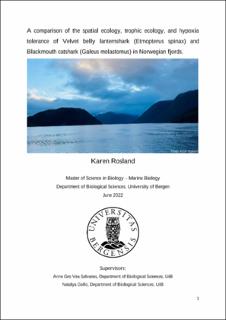| dc.description.abstract | Climate change and ocean warming are major drivers of deoxygenation in the ocean, and the effects of oxygen loss are more pronounced in fjords due to the basic fjord topography. Velvet belly lanternshark (Etmopterus spinax) and Blackmouth catshark (Galeus melastomus) are common sharks in western Norwegian fjords, and though the ecology of these sharks has been more extensively studied elsewhere, studies from Norwegian fjords and in oxygen poor environments are lacking. This study uses survey data in combination with stomach content analysis and stable isotopes to explore and compare the spatial and trophic ecology, energetic physiology, and hypoxia tolerance of the two sharks. Abundance data include samples from 2020-2021 from Fensfjord and 2011-2021 from Masfjord where an extensive basin water oxygen loss occurred. While E. spinax presented a broad vertical distribution that extend from the seafloor and into the pelagic zone, G. melastomus was found to live and feed along the bottom. A clear difference was found in the species’ diet, which was further demonstrated by their stable isotope signatures that presented G. melastomus to feed at one trophic level higher than E. spinax. Stomach content revealed a benthic associated diet of G. melastomus and a more pelagic diet of E. spinax. Furthermore, results show that E. spinax had a more efficient energy storage with a hepatosomatic index (HSI) of 20% and a water content of only 8%. In comparison, G. melastomus had an average HSI of 5% and a water content of ~30%. Most surprisingly our dataset revealed no clear effects of low oxygen levels on the ecology of either shark species. Our results increase the knowledge on these species and fill knowledge gaps on their ecology and hypoxia tolerance, especially in Norwegian fjords where information previously has been lacking. Increased knowledge on these species in hypoxic conditions is essential for future management purposes as the effects of climate change further accelerate. | |
